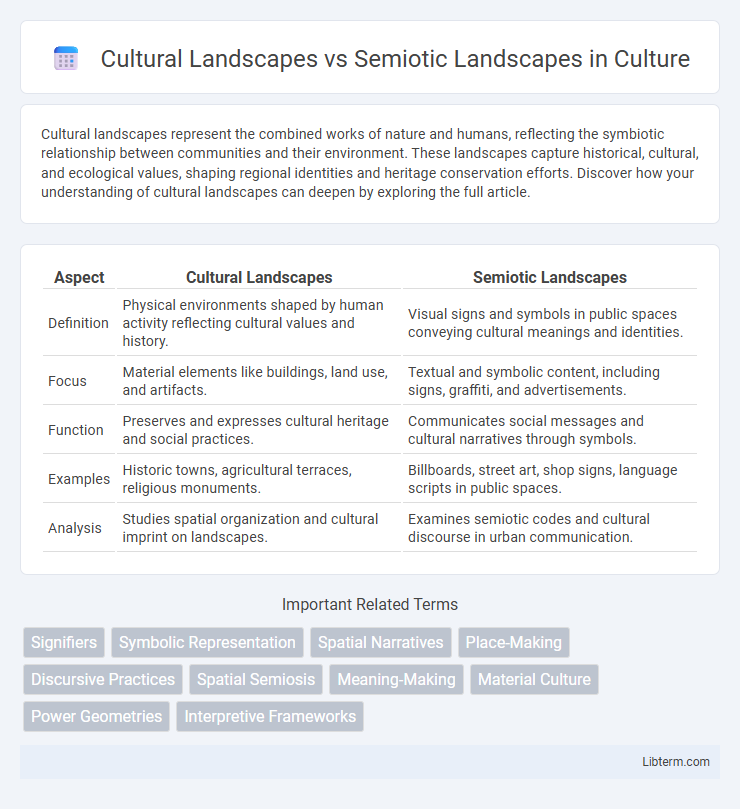Cultural landscapes represent the combined works of nature and humans, reflecting the symbiotic relationship between communities and their environment. These landscapes capture historical, cultural, and ecological values, shaping regional identities and heritage conservation efforts. Discover how your understanding of cultural landscapes can deepen by exploring the full article.
Table of Comparison
| Aspect | Cultural Landscapes | Semiotic Landscapes |
|---|---|---|
| Definition | Physical environments shaped by human activity reflecting cultural values and history. | Visual signs and symbols in public spaces conveying cultural meanings and identities. |
| Focus | Material elements like buildings, land use, and artifacts. | Textual and symbolic content, including signs, graffiti, and advertisements. |
| Function | Preserves and expresses cultural heritage and social practices. | Communicates social messages and cultural narratives through symbols. |
| Examples | Historic towns, agricultural terraces, religious monuments. | Billboards, street art, shop signs, language scripts in public spaces. |
| Analysis | Studies spatial organization and cultural imprint on landscapes. | Examines semiotic codes and cultural discourse in urban communication. |
Introduction to Cultural and Semiotic Landscapes
Cultural landscapes represent the physical imprint of human activity on the natural environment, reflecting historical, social, and cultural processes through architecture, land use, and spatial organization. Semiotic landscapes emphasize the symbolic meanings conveyed by signs, symbols, and language embedded in public spaces, revealing cultural identities, power relations, and communication patterns within a community. Understanding both cultural and semiotic landscapes provides critical insight into how places are shaped by human values and how meaning is constructed and interpreted in geographical contexts.
Defining Cultural Landscapes
Cultural landscapes are geographic areas shaped by human activity, reflecting the interaction between natural environment and cultural practices, including architecture, land use, and historical landmarks. These landscapes embody the tangible heritage and collective memory of communities, revealing social values, traditions, and identities imprinted on the physical terrain. Unlike semiotic landscapes, which emphasize symbolic communication through signage and text, cultural landscapes represent the broader material and spatial expressions of culture within a specific environment.
Exploring Semiotic Landscapes
Semiotic landscapes refer to the visible signs, symbols, and language embedded in public spaces that convey cultural meanings and identities. Exploring semiotic landscapes involves analyzing graffiti, billboards, street art, and signage to understand social power dynamics, community values, and linguistic diversity. This approach reveals how communities communicate and negotiate cultural narratives through everyday visual elements in urban environments.
Historical Contexts and Evolution
Cultural landscapes reflect the physical imprint of human activity shaped by historical events, traditions, and social practices over time, exemplifying the evolution of societies through architecture, agriculture, and land use. Semiotic landscapes, by contrast, emphasize the symbolic and communicative aspects embedded in urban signage, advertisements, and public texts, evolving alongside cultural identity and power relations. Both landscapes reveal the dynamic interplay between history and meaning, with cultural landscapes documenting tangible heritage and semiotic landscapes capturing ideological shifts.
The Role of Symbols in Shaping Landscapes
Symbols play a critical role in shaping both cultural and semiotic landscapes by embedding meanings that reflect social values, historical narratives, and identity. Cultural landscapes physically manifest the relationship between people and their environment through landmarks and monuments that symbolize collective memory and tradition. Semiotic landscapes extend this by interpreting signs, language, and symbols within the urban environment, creating layers of meaning that influence perception and social interaction.
Intersections and Divergences
Cultural landscapes represent the visible imprint of human activity on the environment, reflecting historical, social, and economic dimensions, while semiotic landscapes emphasize the symbolic meanings embedded in signage, language, and visual markers within a space. Both concepts intersect in their analysis of human-environment interaction and the transmission of cultural identity, yet they diverge in scope, as cultural landscapes encompass broader physical and ecological features, whereas semiotic landscapes focus narrowly on communicative elements. Understanding these distinctions is essential for interdisciplinary studies in geography, anthropology, and urban planning, where the interplay of material context and semiotic content shapes community perception and spatial experience.
Case Studies: Real-World Examples
Cultural landscapes, such as Machu Picchu in Peru, embody the tangible interaction between human activity and natural environments, reflecting centuries of social, agricultural, and spiritual practices. Semiotic landscapes, exemplified by New York City's Times Square, communicate cultural meanings through symbolic signs and advertisements that shape urban identity and public perception. Comparative case studies reveal how cultural landscapes preserve historical narratives while semiotic landscapes continuously evolve, representing dynamic cultural expressions in contemporary society.
Impacts on Identity and Community
Cultural landscapes embody tangible expressions of a community's heritage, directly shaping collective identity through physical monuments, architecture, and land use patterns that reinforce shared history and values. Semiotic landscapes, composed of signs and symbols such as language, advertisements, and public art, subtly influence community identity by communicating socio-political messages and cultural narratives in public spaces. The interplay between these landscapes affects social cohesion and belonging, with cultural landscapes anchoring identity in place while semiotic landscapes continuously negotiate and redefine community meaning and power relations.
Challenges in Interpretation and Preservation
Interpreting cultural landscapes involves challenges related to the layered meanings embedded in physical environments shaped by historical, social, and environmental factors, which require multidisciplinary approaches for accurate preservation. Semiotic landscapes, characterized by the symbolism and language of public signage and visual text, face preservation challenges tied to linguistic shifts, urban redevelopment, and the transient nature of signs that reflect changing cultural identities. Both types demand nuanced strategies that balance respect for intangible cultural expressions with the physical conservation of landscapes in dynamic social contexts.
Conclusion: Future Directions and Research
Future research in cultural landscapes should emphasize integrating advanced geospatial technologies with community-driven narratives to capture evolving cultural expressions. Semiotic landscapes demand deeper interdisciplinary studies combining semiotics, urban studies, and digital media to decode emerging symbolic interactions in public spaces. Exploring the interplay between tangible heritage and digital symbolism can reveal new dimensions in how societies negotiate identity and memory.
Cultural Landscapes Infographic

 libterm.com
libterm.com